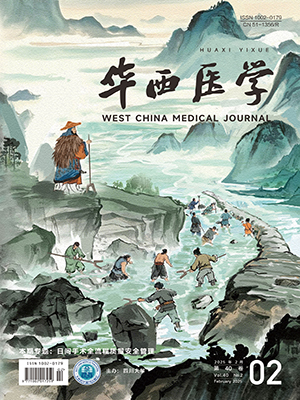| 1. |
喻微, 叶波, 续力云, 等. 实性孤立性肺结节诊断模型的建立. 中国肺癌杂志, 2016, 19(10): 705-710.
|
| 2. |
姜男, 陈小岑, 赵岳. 肺癌患者同步放化疗期间症状群的调查研究. 中国全科医学, 2012, 15(33): 3866-3869.
|
| 3. |
李焱, 杨敬敬. 沙利度胺与 NP 方案联合治疗晚期非小细胞肺癌的疗效观察. 疑难病杂志, 2011, 10(6): 435-437.
|
| 4. |
仇蓉, 吴绮珣, 周娟, 等. 知信行模式干预对细胞因子诱导的杀伤细胞生物治疗中晚期肺癌患者疼痛的影响. 护理管理杂志, 2015, 15(11): 805-807.
|
| 5. |
宫伟利. 延续性自我管理对肺癌患者癌因性疲乏和生命质量的影响. 护理管理杂志, 2015, 15(10): 746-747.
|
| 6. |
李玉, 李丽, 王国权, 等. 癌症护理研究现状及趋势. 解放军护理杂志, 2016, 33(4): 46-50.
|
| 7. |
Dodd MJ, Miaskowski C, Paul SM. Symptom clusters and their effect on the functional status of patients with cancer. Oncol Nurs Forum, 2001, 28(3): 465-470.
|
| 8. |
臧瑜, 于虹, 李妍, 等. 肺癌患者症状群的调查研究. 中华护理杂志, 2016, 51(3): 316-320.
|
| 9. |
Wang XS, Wang Y, Guo H, et al. Chinese version of the M. D. Anderson Symptom Inventory: validation and application of symptom measurement in cancer patients. Cancer, 2004, 101(8): 1890-1901.
|
| 10. |
Mendoza TR, Wang XS, Lu C, et al. Measuring the symptom burden of lung cancer: the validity and utility of the lung cancer module of the M. D. Anderson Symptom Inventory. Oncologist, 2011, 16(2): 217-227.
|
| 11. |
张立力, 臧瑜. MD 安德森症状评估量表肺癌模块的修订和考评. 肿瘤, 2013, 33(5): 434-438.
|
| 12. |
Maguire R, Stoddart K, Flowers P, et al. An interpretative phenomenological analysis of the lived experience of multiple concurrent symptoms in patients with lung cancer: a contribution to the study of symptom clusters. Eur J Oncol Nurs, 2014, 18(3): 310-315.
|
| 13. |
Henoch I, Lövgren M. The influence of symptom clusters and the most distressing concerns regarding quality of life among patients with inoperable lung cancer. Eur J Oncol Nurs, 2014, 18(3): 236-241.
|
| 14. |
Reyes-Gibby CC, Swartz MD, Yu X, et al. Symptom clusters of pain, depressed mood, and fatigue in lung cancer: assessing the role of cytokine genes. Support Care Cancer, 2013, 21(11): 3117-3125.
|
| 15. |
Hsieh CC, Hsiao FH. The effects of supportive care interventions on depressive symptoms among patients with lung cancer: a meta analysis of randomized controlled studies. Palliat Support Care. (2017-05-14)[2017-06-01]. https://doi.org/10.1017/ S1478951517000335.
|
| 16. |
Shen CH, Yang LY. The effects of acupressure on meridian energy as well as nausea and vomiting in lung cancer patients receiving chemotherapy. Biol Res Nurs, 2017, 19(2): 145-152.
|
| 17. |
Hochberg U, Elgueta MF, Perez J. Interventional analgesic management of lung cancer pain. Front Oncol, 2017, 7: 17.
|
| 18. |
Long NH, Thanasilp S, Thato R. A causal model for fatigue in lung cancer patients receiving chemotherapy. Eur J Oncol Nurs, 2016, 21(21): 242-247.
|
| 19. |
Hung R, Krebs P, Coups EJ, et al. Fatigue and functional impairment in early-stage non-small cell lung cancer survivors. J Pain Symptom Manage, 2011, 41(2): 426-435.
|
| 20. |
Lou VW, Chen EJ, Jian H, et al. Respiratory symptoms, sleep, and quality of life in patients with advanced lung cancer. J Pain Symptom Manage, 2017, 53(2): 250-256.e1.
|
| 21. |
Dong ST, Costa DS, Butow PN, et al. Symptom clusters in advanced cancer patients: an empirical comparison of statistical methods and the impact on quality of life. J Pain Symptom Manage, 2016, 51(1): 88-98.
|
| 22. |
Trudel-Fitzgerald C, Savard J, Ivers H. Which symptoms come first? Exploration of temporal relationships between cancer-related symptoms over an 18-month period. Ann Behav Med, 2013, 45(3): 329-337.
|
| 23. |
魏婷婷. 肺癌患者放疗期间睡眠障碍与临床因素及免疫学指标关系研究. 天津: 天津医科大学, 2016.
|
| 24. |
Chen E, Nguyen J, Cramarossa G, et al. Symptom clusters in patients with lung cancer: a literature review. Expert Rev Pharmacoecon Outcomes Res, 2011, 11(4): 433-439.
|
| 25. |
Crawford JR, Smith G, Maylor EA, et al. The prospective and retrospective memory questionnaire (PRMQ): normative data and latent structure in a large non-clinical sample. Memory, 2003, 11(3): 261-275.
|
| 26. |
Jiménez A, Madero R, Alonso A, et al. Symptom clusters in advanced cancer. J Pain Symptom Manage, 2010, 42(1): 24-31.
|
| 27. |
周丽群, 凌云巧, 陈莉莉, 等. 辨证施护全程管理对肺癌患者干预研究. 辽宁中医药大学学报, 2017, 19(4): 197-199.
|
| 28. |
王丹丹, 付菊芳, 房宁宁, 等. 肺癌患者的症状群及其与生活质量的相关性. 护理学杂志, 2012, 27(23): 5-8.
|




